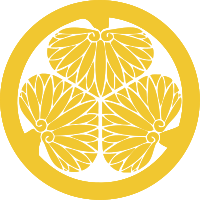
Maruni-mitsuba-aoi ("Circle Around Three Hollyhock Leaves"), the Tokugawa clan mon (crest).
The Tokugawa clan (徳川氏 Tokugawa-shi or Tokugawa-uji) was a powerful daimyo family of Japan. They nominally descended from Emperor Seiwa (850–880) and were a branch of the Minamoto clan (Seiwa Genji) by the Nitta clan. However, the early history of this clan remains a mystery.[1] Members of the clan ruled Japan as Shoguns from 1603 to 1867.
History[]
Minamoto no Yoshishige (+1202), grandson of Minamoto no Yoshiie (1041–1108), was the first to take the name of Nitta. He sided with his cousin Minamoto no Yoritomo against the Taira clan (1180) and accompanied him to Kamakura. Nitta Yoshisue, 4th son of Yoshishige, settled at Tokugawa (Kozuke province) and took the name of that place. However, their provincial history book did not mention Minamoto clan and Nitta clan.[2]
The nominal originator of the Matsudaira clan was reportedly Matsudaira Chikauji, who was originally a poor Buddhist monk.[1][3] He reportedly descended from Nitta Yoshisue in the 8th generation and witnessed the ruin of the Nitta in their war against the Ashikaga. He settled at Matsudaira (Mikawa province) and was adopted by his wife's family. Their provincial history book claimed that this original clan was Ariwara clan.[2] Because this place is said to have been reclaimed by Nobumori Ariwara, one theory holds that Matsudaira clan was related to Ariwara no Narihira.[4]
Matsudaira Nobumitsu (15th century), son of Chikauji, was in charge of Okazaki Castle, and strengthened the authority of his family in the Mikawa province. Nobumitsu's great-great-grandson Matsudaira Kiyoyasu made his clan strong, but was assassinated. In 1567, his grandson Ieyasu (1542–1616) obtained from the Emperor permission to revive the name Tokugawa. In so doing, he claimed descent from the Minamoto clan.
The clan rose to power at the end of the Sengoku period, and to the end of the Edo period they ruled Japan as shoguns. All in all, there were fifteen Tokugawa shoguns. Their dominance was so strong that some history books use the term "Tokugawa era" instead of "Edo period".
In addition, the heads of the gosanke (the three branches with fiefs in Owari, Kishū, and Mito) bore the Tokugawa surname. Additional branches became the gosankyō: the Tayasu, Hitotsubashi, and Shimizu Tokugawa clans. Many daimyo with the Matsudaira surname were descended from the Tokugawa. Examples include the Matsudaira of Fukui and Aizu. Members of the Tokugawa clan intermarried with prominent daimyo and the Imperial family.
Their principal family shrine is the Tōshō-gū in Nikkō, and principal temple is at Kan'ei-ji in Tokyo. Heirlooms of the clan are partly administered by the Tokugawa Memorial Foundation.
Family tree[]
Crest[]
Tokugawa's clan crest, known in Japanese as a "mon", the "triple hollyhock" (although commonly, but mistakenly identified as "hollyhock", the "aoi" actually belongs to the birthwort family and translates as "wild ginger"—Asarum), has been a readily recognized icon in Japan, symbolizing in equal parts the Tokugawa clan and the last shogunate.
The crest derives from a mythical clan, the Kamo clan, which legendarily descended from Yatagarasu.[5] Matsudaira village was located in Higashikamo District, Aichi Prefecture. Although Emperor Go-Yōzei offered a new crest, Ieyasu continued to use the crest, which was not related to Minamoto clan.[6]
In jidaigeki, the crest is often shown to locate the story in the Edo period. And in works set in during the Meiji Restoration movement, the crest is used to show the bearer's allegiance to the shogunate—as opposed to the royalists, whose cause is symbolized by the Imperial throne's chrysanthemum crest. Compare with the red and white rose iconography of English Wars of the Roses, as imagined by Walter Scott earlier in the 19th century, in Anne of Geierstein (1829).
Family members[]
- Tokugawa Ieyasu
- Tokugawa Hidetada
- Matsudaira Nobuyasu
- Yūki Hideyasu
- Matsudaira Ietada
- Matsudaira Tadaaki
- Matsudaira Tadanao
- Matsudaira Tadatsune
- Tokugawa Mitsukuni
- Tokugawa Iesada
Retainers[]
Clans[]
- Abe clan of Mikawa Province
- Gosankyō
- Baba clan
- Honda clan
- Ii clan
- Ishikawa clan
- Sakai clan
- Toda clan
Important retainers[]
|
|
|
|
References[]
- ↑ 1.0 1.1 (Japanese) "徳川家康展". Aichi Prefectural Library. http://www.aichi-pref-library.jp/chiki/jyousetsu_7.html. Retrieved 2008-12-28.
- ↑ 2.0 2.1 (Japanese) "十四松平の城・寺・墓を訪ねて". Okazaki. 2000. http://www.city.okazaki.aichi.jp/museum/db/kkp/H12-09-15/ky00401.htm. Retrieved 2008-12-27.
- ↑ (Japanese) Ryotaro Shiba (1962). "Ieyasu Tokugawa". Shinchosha. http://www.shinchosha.co.jp/books/html/115244.html. Retrieved 2008-12-29.
- ↑ (Japanese) Kazue Tanaka. 古代史の謎を解き明かす「モード・タ」. Google books. via Bungeisha. 2000. 101.
- ↑ (Japanese) "賀茂別雷神社". Kyoto sightseeing taxi. http://www4.ocn.ne.jp/~taxi/kamigamojinjya.html. Retrieved 2008-12-30.
- ↑ (Japanese) Ryu Miura. 戦国武将・闇に消されたミステリー. Google books. via PHP Kenkyusho. 2005. 283.
External links[]
| Wikimedia Commons has media related to Tokugawa clan. |
The original article can be found at Tokugawa clan and the edit history here.